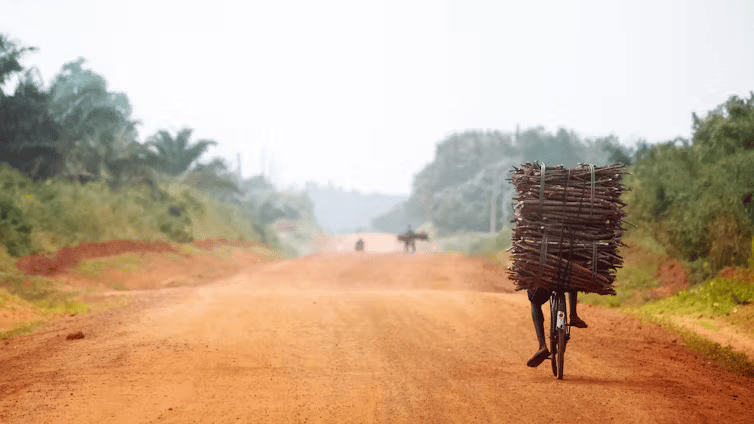
Omanyano ovanhu koikundaneki yomalungula kashili paveta, Commisiner Sakaria takunghilile
Veronika Haulenga
Omanyano ovanhu koikundaneki yomalungula kashili paveta, Commisiner Sakaria takunghilile
Veronika Haulenga
Listeners:
Top listeners:
-
play_arrow
Omanyano ovanhu koikundaneki yomalungula kashili paveta, Commisiner Sakaria takunghilile Veronika Haulenga
Bicycles can change lives, especially in rural Africa – new report looks at their use in Ghana and Malawi


Bicycles are particularly valued for carrying loads.
peeterv/Getty Images, CC BY
By Daniel Frey, Massachusetts Institute of Technology (MIT)
To many people around the world bicycles are a crucial means of transport, especially for carrying loads in rural areas. While their benefits are huge and many organisations are working on making access to bicycles a reality, a range of barriers still prevent them from being more widely available in low-income communities – not least of these being their cost. A team of researchers has produced a new report called Access to Affordable Bicycles in Africa. We asked team leader Daniel Frey about their study and its findings.
What did you set out to study?
Low-income households in low-income countries face transportation service gaps, especially in rural areas. Public transport does not always exist and motorised transport is often unaffordable, forcing people to walk long distances to reach schools, markets, healthcare and other basic services. Bicycles have the potential to fill that gap as a more affordable means of transport.
Studies have shown that bicycle use can result in health, economic and social benefits such as improved gender dynamics. For example, women in a household can be more independent if they can afford their own conveyance, so the low cost of bike ownership can be critical to women’s education and employment. But challenges related to bicycle access and adoption persist, calling for continued research and development.
Our study, funded by USAID, sought to understand the background, current state and opportunities for bicycles to benefit underserved communities in sub-Saharan Africa.
How did you go about the research?
The choice of Ghana and Malawi for our study was based on a set of criteria including, but not limited to, bicycle ownership rates, geography, and capacity of local research partners. It is fair to say that the decision was at least partly determined by the fact that the Village Bicycle Project was already active in Ghana. We relied strongly on the efforts of partners at the University of Malawi and the University of Cape Coast in Ghana. Ghana and Malawi provide some insight into differences in a number of dimensions – between west and east Africa, between nations with a coastline and landlocked nations, between relatively flat terrain and hilly areas.
Two overarching research questions guided the study:
- What factors enable or inhibit adoption of bicycles among low-income and other disadvantaged or underserved populations?
- To what extent do existing bicycle solutions perform as expected and meet users’ needs?
The study consisted of three phases over a two-year period from 2020 to 2022. An initial scoping phase included a literature review and key informant interviews. Phase one consisted of 182 interviews with bicycle users, non-users and other stakeholders – 95 in Ghana and 87 in Malawi.
Phase two included data collection through surveys, observation and in-depth interviews with bicycle-owning households. Data were also collected through sensors attached to bicycles. A sensor set and data loggers were developed by an MIT team. As described in his PhD thesis, MIT scholar Amit Gandhi helped to develop a compact, battery-powered suite of sensors that electronically measured distance and time travelled. Wheel rotations and trip durations were measured with a precision real-time clock.
What did you find?
These are the key findings:
- Household dynamics, especially gender dynamics, influence who gets to own and use the bicycle – which is, in most cases, male heads of households.
- Over the course of a day, a single bicycle is often used by different members of the family for different purposes.
- Sensor data revealed that frequency, duration and distance of bicycle trips varied widely across the sample groups. Longer and more frequent trips were taken by rural and older riders with load-carrying bicycles.
- The transport needs of a household can’t always be met by one bicycle. This leaves other members of the family, especially women, with no option but to walk long distances.
- Prohibitive cost, frequent parts failure, and a desire to own a motorised vehicle were often cited as the top barriers to bicycle use. The aspiration to own a motorcycle was an unexpected challenge. It was surprising to us how often a hope for something more expensive could inhibit a person from investing in a more practical, affordable solution.
- Load carrying was reported to be the most desired bicycle feature. For example, many workers need to bring their own tools to work sites.
- A majority of non-users were women who did not know how to ride a bicycle.
- The study did not reveal gender-specific bicycle design preferences. This trend might not persist when a community becomes more familiar with bicycle design options. In locations where bicycle use is common, manufacturers often find that configurations that better accommodate skirts are preferred by female bicycle customers with an intent to commute to work or school.
Why does this study matter?
I see this research as a first step in a longer-term effort to improve mobility and equity. Bicycles have, for over a century, provided remarkable advantages over walking – increasing the range and efficiency of travel.
But there is an extremely wide range in level of bicycle adoption by different countries. There must be some barriers particular to specific regions and/or cultures that at least partly account for observed differences.
This study adds to our emerging understanding of the ways that appropriate technologies are developed and adopted, or else how they may fail to be widely used.
If we discover that some places have terrain that causes certain mechanical failures, we can re-design bicycle components to be more resilient. If learning to ride is a barrier, then training programmes may help.
This study revealed that a desire to own a motorised vehicle is a barrier to wider use of bicycles. That might deserve some focused attention. Electric power assisted conveyances (such as e-bikes and scooters) have improved a great deal recently. Nevertheless, electric bikes are currently much more expensive than traditional, human-powered bikes, so this continues to present a challenge.
This study has provided several avenues that appear to me as highly promising for work on engineering paired with social science in the interest of environmentally responsible economic development.
The full team of researchers who produced the report is Dan Frey, Megha Hegde, Maggie Hsu, Gwyn Jones, Kendra Leith, Robyn Richmond, Jonars Spielberg and Dan Sweeney![]()
Daniel Frey, Professor of Mechanical Engineering, Massachusetts Institute of Technology (MIT)
This article is republished from The Conversation under a Creative Commons license. Read the original article.
Written by: Contributed
Access Barriers bicycles cost Gender Dynamics Ghana household dynamics load-carrying low-income communities Malawi Research rural areas sensor data study transportation Village Bicycle Project
Similar posts
Windhoek Weather
Most popular

Mbumba signs off new benefits for retired political office bearers

Former FNB employee arrested after defraud pensioner off N$215, 000

Namdia Heist: More questions, lots of confusion

Omuhwahwameki Michael okuunganeka oshikonga shoku patitha oostola dho Rani moshilongo ashihe.

Windhoek woman loses N$60,000 to fraudsters
Copyright 2025 Future Media (Pty) Ltd | Website by Digital Platforms
Tel: +264 83 000 1000 | Email: news@futuremedia.com.na





